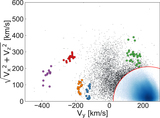One Large Blob and Many Streams Frosting the nearby Stellar Halo in Gaia DR2
Abstract
We explore the phase-space structure of nearby halo stars identified kinematically from the Gaia second data release (DR2). We focus on their distribution in velocity and in “integrals of motion” space, as well as on their photometric properties. Our sample of stars selected to be moving at a relative velocity of at least 210 km s-1, with respect to the Local Standard of Rest, contains an important contribution from the low rotational velocity tail of the disk(s). The V R -distribution of these stars depicts a small asymmetry similar to that seen for the faster rotating thin disk stars near the Sun. We also identify a prominent, slightly retrograde “blob” that traces the metal-poor halo main sequence reported by Gaia Collaboration et al. We also find many small clumps that are especially noticeable in the tails of the velocity distribution of the stars in our sample. Their Hertzsprung-Russell (HR) diagrams disclose narrow sequences characteristic of simple stellar populations. This stream-frosting confirms predictions from cosmological simulations, namely that substructure is most apparent among the fastest moving stars, typically reflecting more recent accretion events.
- Publication:
-
The Astrophysical Journal
- Pub Date:
- June 2018
- DOI:
- 10.3847/2041-8213/aac882
- arXiv:
- arXiv:1804.11347
- Bibcode:
- 2018ApJ...860L..11K
- Keywords:
-
- Galaxy: halo;
- Galaxy: kinematics and dynamics;
- solar neighborhood;
- Astrophysics - Astrophysics of Galaxies
- E-Print:
- 5 pages, 5 figures, accepted for publication in ApJL
